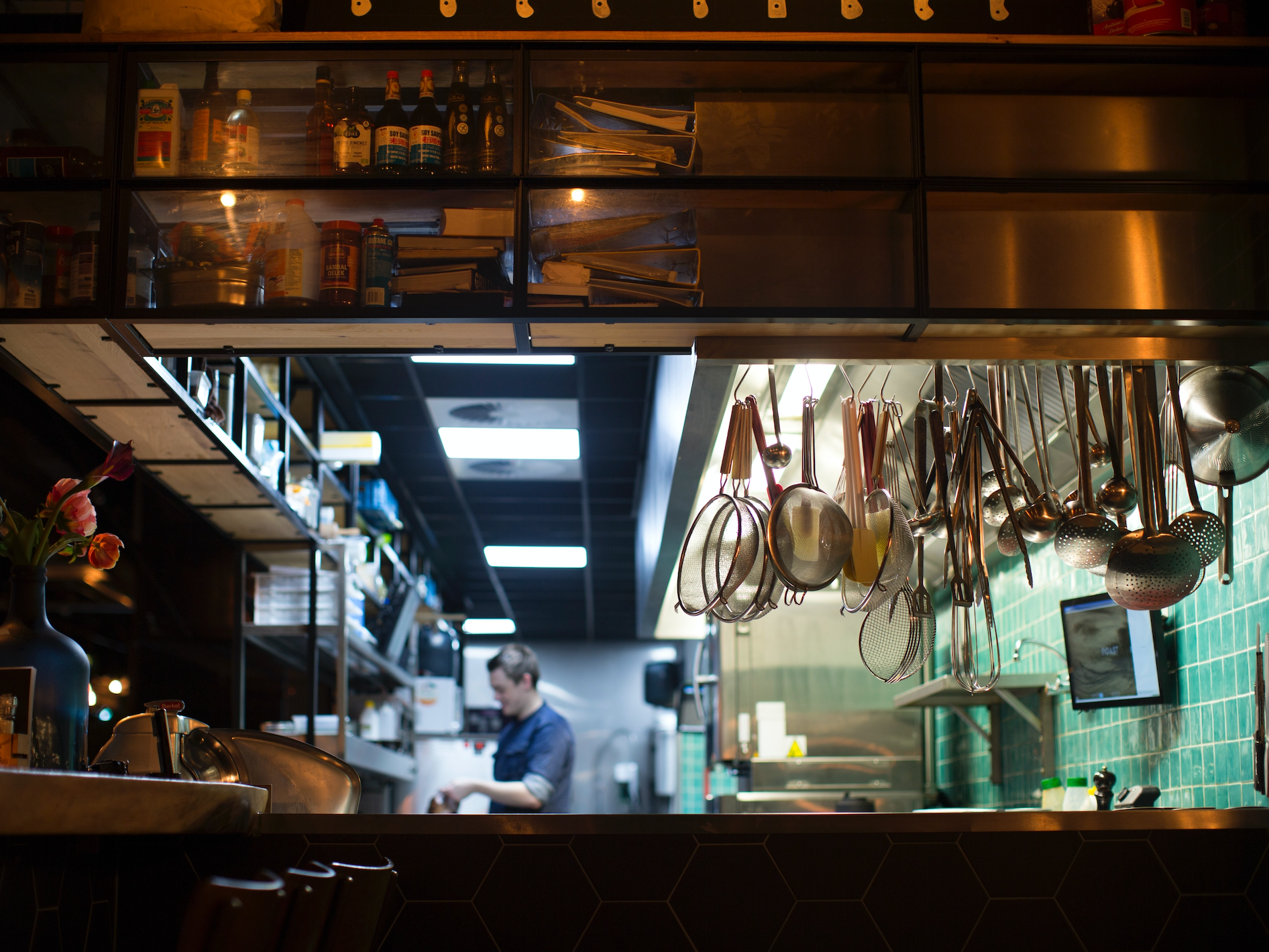Entrepreneurship
Six Commercial Kitchen Layouts for Your Restaurant
By Sarah Al-Waleed

The kitchen is the beating heart of any restaurant. It's what makes your restaurant's main product, the one customers flock to your doors to enjoy and relish its taste. As such, your kitchen's layout and usability should merit considerable thought on your end.
Whether you're opening a new restaurant or renovating an existing one, designing a well-thought-out commercial kitchen can improve your team's overall efficiency and create a memorable dining experience for your guests.
So, how do you go about designing your kitchen? Do you just pick any layout and call it a day? Or is there a little more to it than that? Well, you guessed it (You didn't think I'd let you off that easy, did you?).
Where to Start With Designing Your Commercial Kitchen?
Before diving headfirst into designing your commercial kitchen, there are a few factors you need to take into consideration:
A. Your restaurant's menu
Since the kitchen is where everything on your menu is stored, prepared, and cooked, it should come as no surprise that your restaurant's menu would be the first thing you need to consider. And who better to know the ins and outs of your menu than your own chef?
Your chef can provide you with a wealth of valuable input. They can help you pick the right equipment, set the ratio of the kitchen to the front-of-house, and decide on the size of your storage area. This is not to mention regulating the kitchen's flow to ensure the back-of-house team is operating at maximum efficiency.
B. Your kitchen space
There are many different kitchen layouts out there, yet none are identical. They all differ dramatically based on the restaurant's type and the available space. So, it's crucial to be fully aware of these points before embarking on your kitchen design journey.
Start by taking measurements of your kitchen space, and remember that it's not just a question of square footage. You need to also think about how best to utilize that space to optimize your kitchen's performance.
C. Your local health codes
Lastly, you need to understand your local health codes & safety regulations and secure the proper permits to operate in your area. These requirements and licenses will likely vary significantly based on your restaurant's location.
And if you need help ensuring that everything is above board before designing your commercial kitchen, there is no harm in consulting a local inspector.
10 Crucial Elements to Incorporate into Your Commercial Kitchen Layout
No matter what type of restaurant you're running or which kitchen layout you choose, there are a few key elements that you need to take into account. These elements would be a big help in guiding your design thought process.
1- Simplicity
Simplicity goes hand in hand with functionality. The simpler and less cluttered your kitchen is, the more productive your back-of-house team will be. That's why simplicity should be at the forefront of every design decision you make.
As no restaurant owner can afford to design a kitchen layout that's difficult to navigate, think about how every piece of equipment and every area of the kitchen fits together. Doing so will enable you to simplify your kitchen enough to make your staff's lives easier and improve their performance.
2- Space optimization
To plan your restaurant's space effectively, you must be able to differentiate between necessity and luxury when it comes to kitchen equipment and workstations.
Once you've made that distinction, you'll be able to identify what's essential for your kitchen to operate at maximum capacity and how best to utilize your space.
For instance, you can make equipment serve multiple purposes or workstations perform several tasks. You can also put your kitchen equipment on wheels for easy access and storage.
3- Workflow
Food preparation, cooking, storage, serving, cleaning, and delivery stations are all staples of every commercial kitchen layout. And as such, every one of those stations should be set up in a way that allows it to perform its intended purpose while complementing the functions of other stations.
For example, wouldn't it be better to place your cooking station closer to the serving station rather than waste disposal? Wouldn't it be optimal to place the storage area near the loading area where you receive products from vendors?
Designing a commercial kitchen with a logical workflow in mind can help your staff work without interruptions, reduce confusion, and improve your restaurant's overall performance.
4- Sanitation & safety
Following the proper sanitation and safety guidelines is vital for the safety of your customers. And this has become especially important after COVID-19 reared its ugly head.
When designing your kitchen layout, you'll likely find all the health and safety regulations you need to implement in your local health code manuals. They will probably have instructions on where to place your waste disposal systems, handwashing stations, dishwashers, and cleaning stations.
And while abiding by those regulations is of the utmost importance for you to keep your restaurant's stellar reputation, it's also vital for the safety of your staff. Smoke detectors, fire extinguishers, and suitable fire exits are just a few examples of how you can ensure your staff's safety.
5- Supervision and training
Whichever kitchen layout you choose, you should provide ample space for your more seasoned chefs to supervise and train new employees.
Consider using fewer walls or barriers to make communication easier between your employees. You can also make sure there's plenty of walking room to enable your chefs to oversee everything that's going on.
6- Energy efficiency
Operating a commercial kitchen without being energy-efficient can cost an arm and a leg because they usually consume a lot of power. Most of this power consumption is divided between food preparation, space heating & cooling, and sanitation.
To keep your energy expenditure in check and your costs to a minimum, you'll have to be smart about your kitchen's layout and how you arrange your equipment.
For example, you can place your cold storage equipment far away from your cooking areas so that your refrigerators won't have to work overtime to make up for the excess heat. You can also encourage your staff to turn off equipment, such as commercial fryers, grills, and ovens, when they're not using it.
7- Technology
While some restaurant kitchens may be more technologically savvy than others, all of them can benefit from installing a kitchen display system (KDS).
With a kitchen display system, your BOH team can view every ticket created because it serves as a central repository for all orders.
A KDS also streamlines communications between your kitchen and servers, enables accurate orders to be delivered the first time around, and eliminates the need for kitchen staff to waste time deciphering paper tickets.
8- Air ventilation
Ensuring proper air ventilation in your kitchen is another critical aspect you must consider when designing your kitchen layout. The reason it's so important is that indoor air quality is sure to suffer if air ventilation is not taken into account.
Proper air circulation means there won't be any cooking smells or odors lingering in your kitchen or making their way to your guests. It also means that you'll be able to maintain a safe commercial kitchen space for your staff.
So, make sure to install the right ventilation equipment, such as range fans, kitchen hoods, and ductwork that circulates hot and cold air. And it might be a good idea to have a professional inspect your air ventilation system from time to time to confirm that everything is in tip-top shape.
9- Maintenance
All of your kitchen appliances will eventually need to be serviced or replaced. And when this happens, you need to ensure there's plenty of room for this maintenance to take place.
Suppose you go to work one day and discover that your fridge broke down. The repairman tries to assess the damage but can't fully access your fridge because other kitchen appliances are pressed up right next to it.
Your best bet to account for such a situation is to plan a modular kitchen because it allows you to move parts around and access any equipment easily.
10- Flexibility
Any restaurant's menu is bound to undergo changes or revamps. Therefore, any kitchen design should have a few flexible components to accommodate such changes and allow you to reorganize your space as you see fit. These components might be shelves, racks, or wheeled equipment.
Six Commercial Kitchen Layout Examples
There is no perfect formula for commercial kitchen layouts. Every restaurant is unique and will operate differently than others. Accordingly, you must decide what will help you best meet your kitchen goals.
That said, there are several standard commercial kitchen layouts you can consider that would be an excellent place to start.
-
1. The Island Layout
In this kitchen layout, the entire meal happens at the center of the kitchen. This means that all the cooking equipment, such as ovens, ranges, fryers, and grills, are placed in the middle of the kitchen, much like an island.
In contrast, other kitchen sections, such as food prep, dishwashing, and cleaning, are placed next to the perimeter walls of the kitchen.
Why choose an island layout?
A. It preserves a circular flow that promotes communication and allows for the supervision of staff members.
B. It leaves plenty of open floor space, making things easier to clean.
Which restaurant type is the island layout best suited for?
The island set-up is best for restaurants with plenty of kitchen space for the BOH team to move freely. It also tends to work best for square-shaped venues.
-
2. The Assembly Line Layout
Another popular commercial kitchen layout is the assembly line layout. In this configuration, kitchen equipment is organized in a line, with the food preparation area at one end and the service area at the other. This allows the cooks to quickly assemble the meals and send them down the line.
In this layout, the cleaning, washing, and storage areas are located behind the assembly line to keep them out of the way.
Why choose an assembly line layout?
A. It allows several workers to gather at the same place, each responsible for one part of the food production process.
B. It creates efficiency when dish components move from one station to the next in a consistent, speedy manner.
Which restaurant type is the assembly line best suited for?
The assembly line layout is best for fast food restaurants with limited menus, serving large quantities of the same foods, like sandwiches or pizza.
-
3. Zone-Style Layout
If you choose a zone-style layout, your kitchen will be divided into separate zones for each activity. And you can set up those zones to follow a specific working order for increased flow.
For example, you can divide your kitchen based on utility into a dishwashing zone, a storage zone, a food prep zone, etc. Or you can divide your kitchen based on dish preparation into a soup and salad station, meat station, frying station, baking station, etc.
Why choose a zone-style layout?
A. It keeps the kitchen organized and allows different types of dishes to be prepared simultaneously.
B. It lets the BOH team divide the tasks between them so that each person can focus on their specialty.
C. It facilitates communication and supervision of staff members since the center of the space is completely open.
Which restaurant type is the zone-style best suited for?
This layout is best suited for large operations with diverse menus and many staff members, such as hotel restaurants and catering kitchens.
On the other hand, the zone-style layout is not ideal for smaller venues since it doesn't support multitasking.
-
4. Gallery Layout
In a galley layout, all the stations and kitchen equipment are positioned along the kitchen's perimeter. And If the kitchen is too small, everything can sit along two parallel walls.
Why choose a gallery layout?
A. In a large kitchen, the gallery layout leaves an empty walkway in the center that allows staff to move freely and work multiple stations at the same time.
B. In small kitchens, a gallery layout makes the most of the limited space available.
Which restaurant type is the gallery layout best suited for?
The galley configuration is best for tight spaces with few staff members, like food trucks.
-
5. Open Kitchen Layout
In an open kitchen layout, the commercial kitchen is open to the dining room. That way, customers can watch the chefs as they prepare their meals. (dinner and a show, anyone?)
If you go for an open kitchen layout, installing a glass partition between the service area and the dining room might be a good idea. You might also want to keep all hot cooking appliances as far away from customers as possible.
Why choose an open kitchen layout?
A. It creates an element of entertainment for your guests as they can see all the action that usually takes place behind the scenes.
B. It maximizes the dining room space.
C. It speeds up service because the customers' meals are being prepared just a few feet away from their tables.
Which restaurant type is the open kitchen layout best suited for?
Open kitchen layouts are especially popular among fine dining establishments.
-
6. Ergonomic Layout
Opting for an ergonomic layout for your kitchen means ensuring your employees expend the least amount of energy to complete the most tasks in the shortest amount of time.
In an ergonomic kitchen layout, equipment and supplies are usually placed close to one another to ensure that employees don't go through much trouble to get what they need.
Why choose an ergonomic layout?
A. It lessens the movement in the kitchen, thereby reducing accidents.
B. It creates better working conditions for the BOH team.
C. It boosts speed and efficiency.
Which restaurant type is the ergonomic layout best suited for?
The ergonomic commercial kitchen layout is appropriate for restaurants with unusual kitchen layouts. This is because working conditions in those kitchens may be more difficult, and staff might need to spend longer hours than they have to.
Summary
Running a successful restaurant means minding the smallest details, and your kitchen layout is no small detail to overlook. It's crucial that you put sufficient effort and planning into designing a commercial kitchen layout that's suitable for your business.
A well-planned kitchen layout can positively impact the flow of your entire operation. It increases the productivity & safety of your staff and improves customer satisfaction, all in one fell swoop.
And remember, just because your kitchen produces delicious food doesn't mean there isn't always room to improve on its design and functionality.
Contact Zyda experts now to learn more about how we can help drive your restaurant sales.




